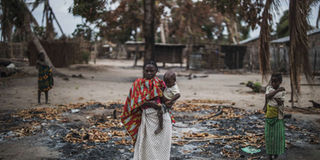Prime
Hunger levels soar to a five-year high in world’s most poor countries

A woman holds her child while standing in a burned out area in the attacked village of Aldeia da Paz outside Macomia in Cabo Delgado Province, in Mozambique, Aug. 24, 2019. Some parts of the world are faced with hunger as a result of civil unrest. PHOTO/FILE/AFP
What you need to know:
- In Africa more than 13 million required humanitarian food aid, with the DRC being the worst hit with at least 5.7 million needing food assistance.
- In East Africa, 32.9 million people face acute food shortage: 75 per cent of them in the Sudan, Ethiopia and South Sudan. In West Africa and the Sahel, 24.8 million people were in crisis almost double the number of 2019 largely due to intensifying conflict, mass displacement and the economic impact of Covid-19.
The number of food insecure people in the world’s poor nations shot to a five-year high in 2020 with millions facing starvation, according to a World Food Programme released this week.
Majority of the 155 million affected are spread across 55 countries around the world, among them more than 15.8 million children of the age less than five, suffering from wasting.
The 2021 Global Report on Food Crises released May 5 by an international alliance of the United Nations, the European Union, governmental and non-governmental agencies working to tackle food crises together, also talks of an increase of around 20 million people from the previous year.
In 2016, 94.2 million people faced food insecurity. And while many people around the world have been pushed to the edge by the economic collapse imposed by Covid-19, many more, particularly in Africa, were driven into food crises by pre-existing fragilities including conflict, poverty, and weather extremities.
“Conflict and hunger are mutually reinforcing. We need to tackle hunger and conflict together to solve either. We must do everything we can to end this vicious cycle. Addressing hunger is a foundation for stability and peace,” said António Guterres, Secretary-General of the United Nations, in the report. Severe job and income losses, often coupled with abruptly escalating and sustained high food prices occasioned by the Covid-19 pandemic meant millions were unable to afford food in sufficient quantity.
Africa is still the continent most affected by food crises, accounting for 63 percent of the global total number of people in crisis or worse, up from 54 percent in 2019. And the alliance has warned that millions could slip into full scale famine while more are expected to join the millions that are acutely food-insecure, should humanitarian intervention fail to reach them.
In just three countries, two of them in Africa, the Central African Republic, South Sudan and Syria, more than half the populations analysed were in acute food crisis or worse, meaning they were unable to meet their daily minimum food needs and were faced with the possibility of starvation, extreme critical acute malnutrition levels, destitution and death, if no interventions were made.
While the three worst global food-crises populations – the DRC, Yemen and Afghanistan – accounted for nearly half of the global total in emergency need for food. South Sudan another one of the worst hit countries had at least 55 per cent of citizens unable to meet their daily minimum food requirements, and 15 per cent in food emergency situation and faced with famine.
High up there in a similar fix on the continent were Central African Republic with 51 per cent and Zimbabwe with 45 per cent of their populations facing pervasive hunger and in some instances famine.
In Africa more than 13 million required humanitarian food aid, with the DRC being the worst hit with at least 5.7 million needing food assistance.
In East Africa, 32.9 million people face acute food shortage: 75 per cent of them in the Sudan, Ethiopia and South Sudan. In West Africa and the Sahel, 24.8 million people were in crisis almost double the number of 2019 largely due to intensifying conflict, mass displacement and the economic impact of Covid-19.



